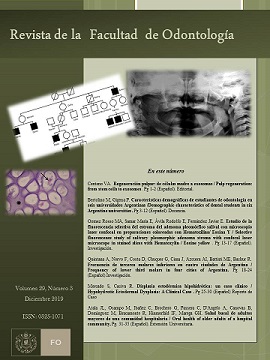Regeneración pulpar: de células madre a exosomas
Palabras clave:
células madres, exosomasResumen
La búsqueda de nuevas herramientas en odontología regenerativa es de extrema importancia y los conocimientos adquiridos ofrecerán la oportunidad para renovar los procedimientos clínicos clásicos por metodologías innovadoras que atraviesen las fronteras actuales en el cuidado de la salud bucal.
Referencias
Tatullo M, Codispoti B, Paduano F, Nuzzolese M. and Makeeva I. Strategic Tools in Regenerative and Translational Dentistry. Int J Mol Sci. 2019; 20:1879-1893.
2. Nicoloso GF, Goldenfum GM, Pizzol TDSD, Scarparo RK, Montagner F, de Almeida Rodrigues J, Casagrande L. Pulp Revascularization or Apexification for the Treatment of Immature Necrotic Permanent Teeth: Systematic Review and Meta-Analysis. J Clin Pediatr Dent. 2019; 43(5):305-313.
3. Cheng J, Jiang G, Tarzemany R, Larjava H, Häkkinen L. Regulation of connexin 43 expression in human gingival fibroblasts. Exp Cell Res. 2018; 371(1):238-249.
4. Li S, He H, Zhang G, Wang F, Zhang P,Tan Y. Connexin43-containing gap junctions potentiate extracellular Ca²⁺-induced odontoblastic differentiation of human dental pulp stem cells via Erk1/2. Exp Cell Res.2015; 338(1):1-9.
5. Wiklander OP, Nordin JZ, O’Loughlin A, Gustafsson Y, Corso G, Mäger I, , Vader P, Yi L, Sork H, Seow Y, Extracellular vesicle in vivo biodistribution is determined by cell source, route of administration and targeting. J. Extracell Vesicles 2015; 4: 26316-23329.
Publicado
Número
Sección
Licencia
Aquellos autores/as que tengan publicaciones con esta revista, aceptan los términos siguientes:
- Los autores/as conservarán sus derechos de autor y garantizarán a la revista el derecho de primera publicación de su obra, el cuál estará simultáneamente sujeto a la Licencia de reconocimiento de Creative Commons que permite a terceros:
- Compartir — copiar y redistribuir el material en cualquier medio o formato
- La licenciante no puede revocar estas libertades en tanto usted siga los términos de la licencia
- Los autores/as podrán adoptar otros acuerdos de licencia no exclusiva de distribución de la versión de la obra publicada (p. ej.: depositarla en un archivo telemático institucional o publicarla en un volumen monográfico) siempre que se indique la publicación inicial en esta revista.
- Se permite y recomienda a los autores/as difundir su obra a través de Internet (p. ej.: en archivos telemáticos institucionales o en su página web) después del su publicación en la revista, lo cual puede producir intercambios interesantes y aumentar las citas de la obra publicada. (Véase El efecto del acceso abierto).

